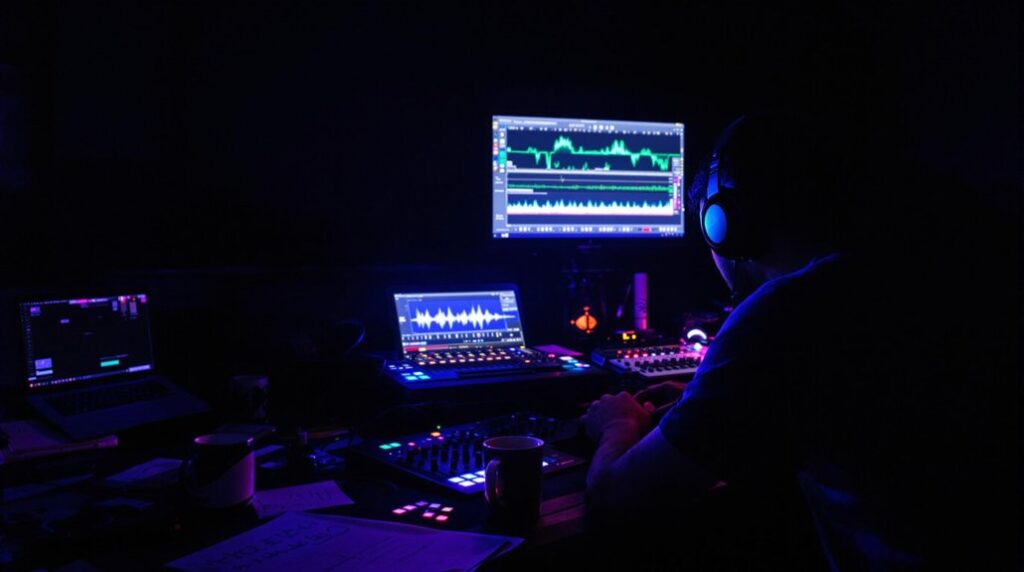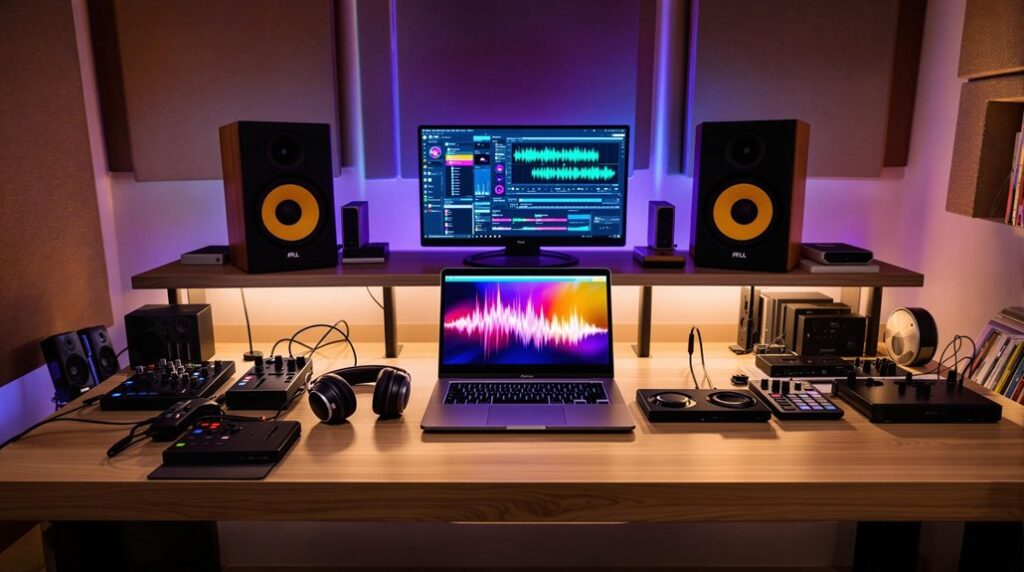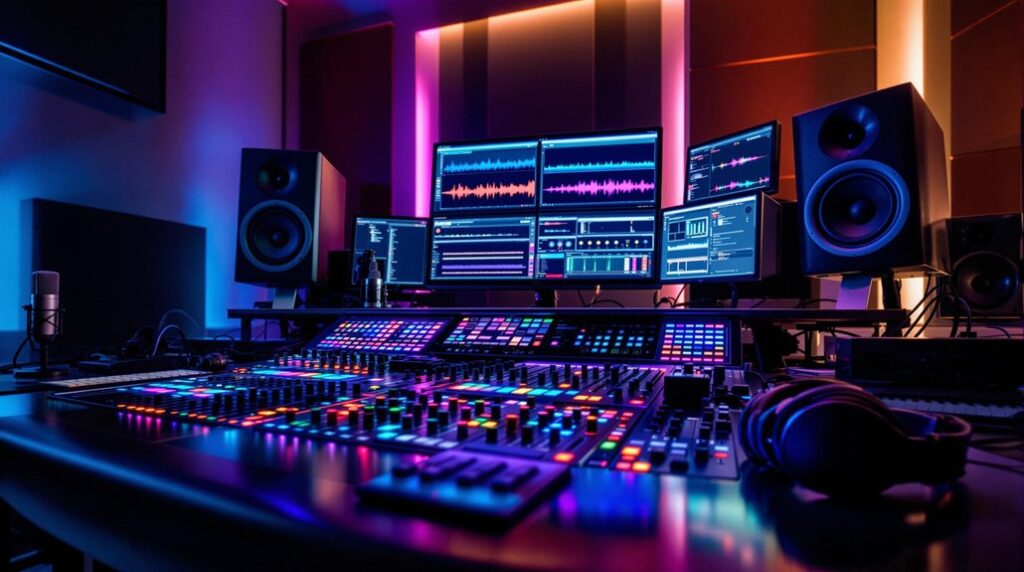Mastering reverb and delay enhances depth and space in your mixes. Reverb, simulating natural reflections, uses settings like decay time and pre-delay to shape environments—from intimate rooms to vast halls. Choose reverb types like plate, room, or hall to match your instruments. For delay, adjust parameters like feedback and modulation to create rhythmic echoes or ambient soundscapes. Sync delay times to your track’s BPM for precision. Combining reverb and delay strategically maintains mix clarity, adding complexity without clutter. By fine-tuning these effects, you’ll achieve a polished, professional sound. Keep exploring to enhance your mixes to new dimensions.
Key Takeaways
- Understand Reverb Types: Different reverb types (room, hall, plate, spring) provide unique spatial effects suited to various instruments and genres.
- Adjust Decay Time: Fine-tune decay time to define the spatial environment and maintain mix clarity.
- Pre-Delay Settings: Use pre-delay to keep the dry signal distinct, adding clarity and definition to the reverb effect.
- Sync Delay to Tempo: Sync delay times to the track’s BPM for cohesive rhythmic patterns and seamless alignment.
- EQ for Reverb: Shape the reverb’s frequency response by cutting low frequencies and boosting mid-high frequencies to maintain clarity and presence.
Understanding Reverb
To master reverb, you need to understand how it simulates natural sound reflections in various environments. Reverb applications are deeply rooted in creating a sense of space and depth within a mix. Critical settings like decay time, pre-delay, and room size play pivotal roles in shaping the reverb effect.
For example, a short decay time creates a tight, controlled environment, while a longer decay time can evoke a large, cavernous space. Pre-delay allows you to adjust the time between the direct sound and the onset of the reverb, helping to maintain clarity.
In reverb sound design, practical examples can guide your approach. For instance, adding a subtle reverb to vocals can make them sit naturally within a mix, enhancing realism. Conversely, a more pronounced reverb can be applied to snare drums to give them a sense of grandeur and presence. Understanding these nuances ensures you apply reverb strategically to achieve a balanced and immersive mix.
Types of Reverb
Now that you understand the fundamentals of reverb, let’s explore the various types of reverb and their unique characteristics that shape your mix.
Room reverb simulates a small space, providing a tight and intimate sound. It’s ideal for vocals or acoustic instruments where you want a close, direct feel. In reverb applications, room reverb excels at adding subtle depth without overwhelming the source.
Hall reverb emulates a large concert hall, offering spacious and grandiose effects. It’s perfect for orchestral arrangements or epic soundscapes, delivering a sense of vastness. When making reverb comparisons, you’ll find hall reverb stands out for its ability to create an immersive environment.
Plate reverb replicates the sound of a vibrating metal plate, creating a bright and smooth ambiance. This type is fantastic for vocals and snares, giving them a polished and professional finish.
Spring reverb mimics the vintage effect of sound bouncing off springs, delivering a distinct and retro tone, often used in guitar amplifiers for a classic rock vibe.
Each reverb type can be customized and experimented with, enhancing different instruments and genres. Reverb customization and reverb experimentation allow you to tailor these effects precisely, ensuring your mix achieves the desired atmosphere.
Choosing Reverb Plugins
When selecting reverb plugins, consider factors like room size, decay time, and modulation options to enhance your mix’s depth and ambiance effectively. Reverb plugin comparisons reveal that options like Valhalla Room, Waves Abbey Road Plates, and FabFilter Pro-R each bring unique sonic characteristics.
For instance, Valhalla Room excels with a wide range of room size selections, while Waves Abbey Road Plates provides a lush, classic plate reverb sound. FabFilter Pro-R stands out for its intuitive interface and extensive customization options.
Understanding the graphical user interface (GUI), presets, and customization tips can streamline your creative process. For example, FabFilter Pro-R’s GUI allows you to visualize and adjust decay times and early reflections with precision. This level of control helps you tailor the reverb to fit your track perfectly.
Additionally, experimenting with modulation effects can add movement and depth to your reverb, making it more dynamic.
When choosing a plugin, always consider how its specific features align with your project’s needs. Plate reverbs can offer a rich, vintage tone, while convolution reverbs provide highly realistic room simulations. By experimenting and comparing different plugins, you’ll find the perfect reverb to complement each track and genre.
Reverb Techniques
Mastering reverb techniques involves fine-tuning parameters like decay time, pre-delay, and high-frequency damping to achieve the desired spatial effect in your mix. Adjusting the decay time alters the length of the reverb tail, making it crucial in defining the perceived size of the space. Short decay times can create the sense of a small room, while longer decay times can simulate larger, more cavernous environments.
Pre-delay settings are crucial for maintaining clarity and depth by determining the time gap between the dry signal and the onset of reverb reflections. A short pre-delay can make the reverb blend more with the original sound, whereas a longer pre-delay can add distinct separation, enhancing the mix’s intelligibility.
Reverb modulation introduces movement and subtle variations to the reverb tail, adding a layer of realism and complexity. This can be particularly effective in preventing the reverb from sounding static or lifeless.
High-frequency damping controls are essential for shaping the brightness of the reverberated signal, allowing you to tailor the reverb’s tonal quality to fit the mix.
Additionally, leveraging early reflections can simulate proximity and add intimacy, making the listener feel closer to the sound source. Remember, a balanced approach to reverb modulation and delay feedback enhances the overall spatial experience.
Understanding Delay
Delving into the world of delay, you’ll discover it creates echoes by repeating the original sound at intervals, adding both depth and rhythmic complexity to your mix. By adjusting parameters like delay modulation and delay feedback, you can shape the texture and rhythm of your tracks with precision.
Delay modulation involves altering the delay time slightly, adding movement and richness to the sound. This technique can make your echoes feel more organic and less mechanical. On the other hand, delay feedback controls how many times the echo repeats. Higher feedback settings can create lush, ambient textures, while lower settings are perfect for tight, rhythmic patterns.
Here’s a quick reference table to help you understand how these parameters affect your sound:
| Parameter | Function | Effect on Sound |
|---|---|---|
| Delay Time | Sets the interval between repeats | Short times = rhythmic, Long times = ambient |
| Delay Feedback | Controls repetition of echoes | Low = subtle, High = dense |
| Delay Modulation | Alters delay time for each repeat | Adds movement and complexity |
Applying delay to various elements like vocals, guitars, percussion, and synths can diversify your sonic landscape significantly. By mastering delay, you’ll add a new dimension to your music production, enriching your mixes with depth and rhythmic interest.
Types of Delay
Exploring the various types of delay will help you understand how each can uniquely shape your mix and add distinct character to your sound.
Analog vs Digital delay is a fundamental distinction. Digital delay offers precise and clean repeats of the original signal, making it perfect for situations where you need clarity and exact replication.
In contrast, analog delay provides warm, organic repeats, often with slight modulation, imparting a vintage feel to your tracks.
Tape emulation is another popular type of delay. This method simulates the sound of tape loops, delivering a classic, saturated tone that can add a nostalgic warmth to your mix. Tape delay is particularly useful if you’re aiming for a retro sound, as it introduces subtle distortions and tape artifacts that enhance the texture of your audio.
Ping-pong delay is a stereo effect where the delayed signal bounces between the left and right channels. This creates a wide, immersive sound field, adding depth and dimension to your mix.
Each of these delay types—whether digital, analog, tape emulation, or ping-pong—offers unique attributes that can greatly enhance your music production palette.
Creative Delay Uses
To harness delay creatively, start by crafting rhythmic patterns that add groove and complexity to your tracks.
You can also use delay to create ambient soundscapes that transform a mix into an immersive experience.
Additionally, applying delay effects to vocals can enhance their presence and add unique character.
Rhythmic Delay Patterns
Setting precise delay times to match the track’s tempo is crucial for creating engaging rhythmic delay patterns that enhance the song’s groove and dynamics. Start by syncing your delay unit to the track’s BPM to achieve rhythmic precision.
Experiment with delay modulation to add subtle variations in the delay times, which can inject movement and life into your mix.
Next, focus on feedback manipulation to control the number of repetitions and their decay rate. High feedback levels can create dense, evolving sonic textures, while lower feedback settings maintain clarity and punch. Tweak these parameters to find the perfect balance that complements the track without overwhelming it.
A common technique is to set delay times to note values like eighths, sixteenths, or triplets. This ensures the delays sit perfectly within the rhythmic framework of the song. Don’t hesitate to experiment with unconventional delay times to discover unique rhythmic patterns that stand out.
Always monitor how the delays interact with the original signal. Too much delay can muddy the mix, while too little might fail to make an impact.
Ambient Soundscapes Creation
Crafting ambient soundscapes with creative delay uses requires a deep understanding of delay settings like time, feedback, and modulation to produce immersive textures and evolving atmospheres.
Begin by adjusting the delay time to create a sense of space; shorter times can produce tight, rhythmic echoes, while longer times yield expansive, drifting repeats that fill the sonic landscape.
Next, experiment with feedback settings to determine how many repeats you want. Higher feedback levels can lead to evolving textures that transform over time, creating a dynamic backdrop for your tracks.
Modulation adds another layer of complexity, subtly altering the pitch and character of each repeat, enhancing the sense of movement and depth.
Combining delay with reverb can further amplify these effects. A well-placed reverb can blend the delayed signals into a cohesive, immersive atmosphere, adding depth and emotion to your music. Be strategic with placement to avoid clutter and maintain clarity.
Vocal Delay Effects
Delays on vocals can transform a flat mix into a vibrant, multidimensional soundscape, enhancing the emotional depth and rhythmic complexity of your tracks. By manipulating delay effects, you can add depth and dimension to vocals, making them stand out in your mix. This technique, known as vocal manipulation, allows you to emphasize certain phrases or words, creating a more engaging listening experience.
To achieve creative vocal delay effects, you need to experiment with various time manipulation settings. Here are some techniques to explore:
- Ping-pong delay: Creates a wide stereo image by alternating the delay between the left and right channels.
- Short delay times: Thickens the vocal sound, adding a sense of presence and immediacy.
- Long delay times: Adds a sense of space and atmosphere, perfect for creating ethereal and ambient effects.
- Feedback and modulation: Adjusting these parameters can produce unique textures, adding complexity to the vocal track.
Combining Reverb and Delay
To master combining reverb and delay, focus on balance and blend techniques to create a cohesive sound. Timing and syncing effects are essential for maintaining rhythmic integrity and avoiding a cluttered mix.
Experiment with creative soundscaping ideas to discover unique textures that enhance your music.
Balance and Blend Techniques
Balancing reverb and delay effectively transforms your mix by creating a cohesive and immersive soundscape. To achieve this, you’ll need to master various techniques involving reverb modulation and delay modulation, as well as wet/dry balance and feedback control. These elements help shape the texture and depth of your mix, guaranteeing each effect complements the other without overpowering the track.
Start by experimenting with different reverb types and delay settings. This helps you find the perfect blend for your mix.
Here are some strategies to explore:
- Use short delays with long reverb tails to add depth and dimension without muddying the mix.
- Apply delay before reverb to create rhythmic patterns and enhance the track’s overall ambience.
- Adjust the wet/dry balance to ensure the effects sit well within the mix and don’t overpower the original signal.
- Control feedback settings to prevent delays from becoming too repetitive or overwhelming.
Each of these techniques requires careful tweaking to achieve the desired outcome.
Balancing and blending reverb and delay effectively can enhance your mix by adding texture, depth, and emotion, ultimately creating a more engaging listening experience.
Timing and Syncing Effects
Syncing reverb and delay effects to your track’s tempo guarantees each element aligns perfectly with the beat, adding cohesion and enhancing the overall musicality. By achieving tempo synchronization, you secure reverb tails and delay repeats land precisely on the song’s beats, fostering rhythmic cohesion. This careful timing adjustment contributes to a polished and professional sound, making each instrument and vocal sit well within the mix.
To achieve seamless alignment, start by setting your delay time to match the song’s BPM. Most delay plugins offer a tempo-sync feature, allowing you to select note subdivisions like quarter notes, eighth notes, or dotted patterns. Adjust the reverb’s pre-delay to complement the delay’s timing, ensuring they work in tandem rather than clashing. This combination adds musical depth, creating an immersive audio experience.
When you sync reverb and delay effects, you’re not just adding space but also movement to the audio landscape. The precise synchronization creates a sense of space and atmosphere that complements the music, making it feel more dynamic and engaging. Mastering this technique can transform your mix, giving it the depth and cohesion that sets professional tracks apart.
Creative Soundscaping Ideas
Combining reverb and delay can transform ordinary tracks into rich, immersive soundscapes that captivate the listener with depth and dimension. By carefully balancing these effects, you can craft unique spatial layering and ethereal textures that enhance your mix.
To start, consider using longer reverb tails with subtle delays. This technique enhances the sense of space and distance, making your mix feel more expansive. Experimenting with different delay timings within reverb reflections can add rhythmic interest and movement, giving the sound a dynamic quality.
Here are some creative ideas to explore:
- Layer multiple reverbs: Use varying delay patterns to create complex, evolving textures.
- Adjust delay feedback: Increase the feedback to sustain the delay, adding more layers to your sound.
- Synchronize delays: Match delay times with the tempo of your track for cohesive, rhythmic effects.
- Balance levels: Maintain clarity by carefully adjusting the mix levels of reverb and delay.
Properly balancing these elements ensures that your mix remains coherent and avoids becoming muddy. By integrating these techniques, you can achieve a sophisticated soundscape that resonates with listeners, bringing your music production to the next level.
Mixing Tips and Best Practices
You can enhance your mix by strategically adjusting reverb decay time to shape the spatial environment and maintain clarity. One of the essential mixing strategies involves placing reverb and delay in your effects chains thoughtfully. By doing so, you achieve spatial enhancement and maintain signal separation, preventing your mix from sounding cluttered.
To further define your sound, use pre-delay settings. This allows the dry signal to remain distinct before the reverb reflections kick in, adding clarity and definition. Experiment with different reverb types—plate, hall, room, and spring—each bringing unique spatial effects to your mix.
For example, plate reverb can add smooth, dense reflections ideal for vocals, while room reverb can simulate the natural acoustics of a smaller space, perfect for drums. Utilize EQ to shape the reverb’s frequency response. Cutting low frequencies can prevent muddiness, while boosting specific mid-high frequencies can make the reverb more present without overpowering other elements.
Lastly, combining delay and reverb creatively can add depth and atmosphere, enhancing vocals, drums, and instruments. A short delay with minimal feedback can create a sense of space without overwhelming the mix, while a longer delay can add rhythmic complexity.
Frequently Asked Questions
Is Reverb Good for Mastering?
Yes, reverb is beneficial for mastering. Use different reverb types and mixing tips to add depth and cohesion. Apply it subtly to enhance realism and create a polished, unified sound that enhances your music’s quality and impact.
Should You Use Reverb and Delay Together?
You should use reverb and delay together. Combining precise reverb settings with innovative delay techniques creates depth and texture. This approach enriches your mix and enhances emotional impact while maintaining clarity and cohesion. Experiment for unique results.
What Is Pre-Delay in Chorus?
Pre-delay in chorus is the gap between the original signal and the reverb onset. Adjusting it enhances modulation depth and stereo width, creating spaciousness and separation. Proper pre-delay settings add anticipation and dynamic movement to your mix.
What Is Reverb in Music?
Reverb in music simulates sound reflections in various acoustic environments. It replicates natural reflections to add depth and space to recordings. You can adjust parameters like decay time and diffusion for a balanced, immersive mix.
Conclusion
Mastering reverb and delay enhances your mixes, adding depth and dimension. By understanding different types and techniques, selecting the right plugins, and creatively combining both effects, you can enhance your sound.
Remember, subtlety is key—too much can muddy the mix. Practice these skills, trust your ears, and refine your approach. With precision and clarity, you’ll craft professional, polished tracks that stand out.
Keep experimenting, and you’ll continually improve your audio artistry.




